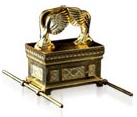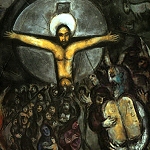|
THE CHRONOLOGY OF THE EVENTS surrounding Israel's experience at Sinai can be perplexing to understand. For instance, we know that Moses received the tablets with the Ten Commandments twice - once before the Sin of the Golden Calf (which were subsequently smashed), and a second time after God had forgiven the people for their idolatry. What is often overlooked, however, is that in his role as Israel's mediator, Moses actually ascended Sinai no less than eight times... In some cases Moses functioned as a "broker" between the Israelites and God; at other times, he revealed specific terms of the covenant (i.e., laws for the people to obey), and at still other times he received the tablets and instructions about building the Tabernacle. In light of his multiple trips up and down the mountain, the relationship between the covenant offered to Israel, the Ten Commandments, and the purpose of the Tabernacle can be a bit difficult to ascertain. In what follows, I hope to work through some of the texts to get a better idea of how we might understand the chronology and significance of these events...
The First Ascent (the call of Moses)
Moses first encountered the LORD at Sinai, "the mountain of God" (הַר הָאֱלהִים), nearly 40 years after he had fled from Pharaoh, while he worked as a shepherd for his father-in-law Jethro in Midian. According to midrash, the Angel of the LORD appeared to Moses in a flame of fire "out of the midst of a thorn bush" on Nisan 15 - the same day that Abraham once had his vision of his decendants in bondage (Gen. 15:12-14). As Moses gazed in wonder, God called out to him and commanded him to remove his sandals because the place (i.e., ha-makom: הַמָּקוֹם) he was standing was holy (i.e., kodesh: קדֶשׁ). God then identified Himself as "the God of Abraham, the God of Isaac, and the God of Jacob." The LORD then said he had seen the affliction of his people in Egypt and heard their cries. "I know their sufferings and have come down to deliver them." The Angel then told Moses that he was chosen to be the LORD's emissary to Pharaoh to take the children of Israel from Egypt back to the promised land (Exod. 3:1-10). God assured Moses that He would be with him, and "this shall be the sign (הָאוֹת) that I have indeed sent you: when you have brought the people out of Egypt, you shall serve God on this mountain" (Exod. 3:12).
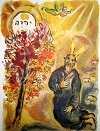
Exactly one year after Moses first encountered God at the burning bush at Sinai, the children of Israel left Egypt (i.e., on Nisan 15 of the original Passover). Instead of leading Israel along a direct route to the Promised Land, however, God directed them south, into the desert, so that He could meet with Moses and the Israelites at Mount Sinai as He had promised. The Shekhinah Glory appeared as a Pillar of Cloud by day (עַמּוּד עָנָן) and as a Pillar of Fire by night (עַמּוּד אֵשׁ) to lead them on their way (Exod. 13:20-22). Three days after the Exodus (i.e., on Nisan 18) Pharaoh mobilized his army and pursued the Jews to bring them back. After two days (i.e., on Nisan 20), Pharaoh and his army reached the Israelites while they were encamped before Baal-Zephon beside the sea (Exod. 14:9). God saved the people as they miraculously crossed the sea that night and destroyed the Egyptian army later that morning. Israel entered the desert on Nisan 21, seven days after the Exodus. The bread from heaven began to fall 30 days after the Exodus (on Iyar 15), and when the people arrived in the arid region of Rephidim (near Sinai) a week later, God gave them water from the Rock. While they were camped at Rephidim, the Amalekites attacked the Israelites but they were defeated as Moses lifted up his staff toward God. Soon afterwards, Moses' father in law Jethro visited Moses and wisely instructed him how to establish order within the camp.
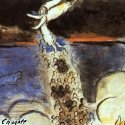
The Second Ascent (the covenant offer)
After Jethro left, the Israelites encamped before Mount Sinai, exactly six weeks after the Exodus (Exod. 19:1-2). There Moses "ascended to God" (עָלָה אֶל־הָאֱלהִים) as God called out to him from the mountain (Exod. 19:3). This was Moses' second ascent to meet with God and fulfilled God's earlier promise that he would one day return with the Israelites to this very place. The LORD delegated him to ask the Israelites whether they would accept His covenant and become his treasured people, and Moses went down the mountain to deliver God's message to the elders of the people. When the elders heard God's proposal, they answered: kol asher dibber Adonai na'aseh, "All that the LORD has spoken we will do."
The Third Ascent (Moses made mediator)
Moses went back up the mountain to report the words of the elders to the LORD (Exod. 19:7-8). During this ascent the LORD explained how he would come in the "thickness of the cloud" (בְּעַב הֶעָנָן) to reveal that he had chosen Moses to be Israel's mediator before Him (Exod. 19:9). The LORD then told Moses to go back to the people and to prepare them to meet with God in three days. "For on the third day the LORD will come down on Mount Sinai in the sight of all the people" (Exod. 19:11). The LORD further instructed Moses to set a boundary around the mountain that no one should cross, for "whoever touches the mountain will be put to death."
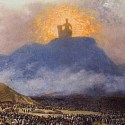
The Fourth Ascent (The Ten Commandments)
On the morning of the third day (i.e., Sivan 6), exactly seven weeks after the Exodus from Egypt, the glory of God descended upon Sinai in a dramatic display of thunder, lightning, billowing smoke and fire, while Moses assembled the people at the foot of the mountain (Exod. 19:15-19). The LORD called Moses to the top of the summit but told him to go back down to again warn the people not to cross the designated boundary (Exod. 19:20-25). After Moses rejoined the people at the foot of the mountain, God began uttering the Ten Commandments (Exod. 20:1-17). Upon hearing the utterances, the people drew back in terror and begged Moses to be their mediator before God (Exod. 20:18-20).
The Fifth Ascent (The Book of the Covenant)
After the people begged him to go, Moses ascended the mountain and "drew near to the thick darkness" where God began to explain to him the laws of idolatry and the laws of the altar (Exod. 20:21-26). During this ascent God also gave Moses various laws (mishpatim) about civil life for the Israelites (Exod. 21:1-23:33).
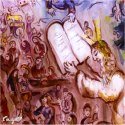
After receiving the various laws for the people, God told Moses to bring Aaron, his sons, and the 70 elders up to the mountain to ratify the terms of the covenant (Exod. 21:1-24:2). Moses then descended Sinai and told the elders all everthing the LORD had said. The people then replied in unison: kol ha-devarim asher dibber Adonai na'aseh: "All the words that the LORD has spoken we will do" (Exod. 24:3). Moses then wrote down the rules into a separate scroll, called Sefer HaBrit (סֵפֶר הַבְּרִית), "the Book of the Covenant," and built an altar at the foot of Mount Sinai with twelve pillars (one for each tribe of Israel). Burnt sacrifices (עלָה) and peace sacrifices (שְׁלָמִים) were then slaughtered (Exod. 24:5). Moses took the sacrificial blood from the offerings, threw half upon the altar and read the book of the covenant to the people. The people ratified the covenant with the words kol asher dibber Adonai na'aseh ve'nishma: "all that the LORD says we will do and obey" (Exod. 24:7). Upon hearing their ratification, Moses took the other half of the sacrificial blood and threw it on the people saying, "Behold the blood of the covenant that the LORD has made with you in accordance with all these words" (Exod. 24:8).
The Sixth Ascent (the ratification meal)
Immediately following this ratification ceremony, Moses took Aaron (and his sons Nadab and Abihu), and seventy of the elders of Israel up to Sinai to eat a "covenant affirmation meal" between the people of Israel and the LORD. The elders of Israel then directly beheld the glory of the God of Israel, under whose feet was "a pavement of sapphires, like the very heaven for clearness" (Exod. 24:9-11).
The Seventh Ascent (the tablets and Tabernacle)
After returning from the mountain with the elders, the LORD commanded Moses to once again go back up the mountain to receive the tablets of stone inscribed with the Ten Commandments (Exod. 24:12). Moses then ascended the mountain, which was still covered by a shining cloud of fire. On the seventh day there - during his seventh ascent - Moses heard the Voice of the LORD calling to him from the midst of the cloud and entered into the midst of Presence of the LORD. He remained on the mountain for a total of 40 days and 40 nights while the Israelites waited for him at the camp down below (Exod. 24:15-18).
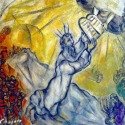
While upon the mountain, the LORD instructed Moses to ask the people for a contribution (terumah) for the various materials needed to build the tabernacle (i.e., mishkan), a tent-like structure that would symbolize the Divine Presence among the people. Gold, silver, brass, red and purple yarns, fine linens, oils, spices, precious stones, etc., all were needed. The LORD said to Moses, "Let them make me a sanctuary (i.e., mikdash: מִקְדָּשׁ) so that I may dwell in their midst. Exactly as I show you concerning the pattern of the tabernacle, and of all its furniture, so you shall make it" (Exod. 25:8-9).
The Mishkan would consist of two main parts: a tent-like structure called the ohel (אהֶל) and an outer court called the chotzer (חָצֵר). The tent was 30 amot long (52.5') and 10 amot wide (17.5') and was to be divided into two separate chambers. The innermost chamber was called the "Most Holy place" (קדֶשׁ הַקֳּדָשִׁים), measuring 10x10 amot, that would enclose the Ark of the Testimony (אֲרוֹן הָעֵדֻת). The Most Holy place was to be separated from an adjoining chamber (called the "Holy place") by means of an intricately woven curtain called the parochet. The Holy place was divided into two regions. In the region closest to the parochet were to be placed three special furnishings: a table of "showbread" (שֻׁלְחָן), a menorah (מְנוֹרָה), and an altar of incense (מִזְבַּח הַקְּטרֶת). The altar of incense (often called the Golden Altar) occupied the exact center of the Holy place. The outer court of the Mishkan measured 100 amot long (175') by 50 amot wide (87.5'). On the east side of the courtyard, 30 amot from the entrance, a copper altar was to be used for daily sacrifices. In addition, a copper water basin was to be used by the priests after performing their ministrations. The outer court was to be surrounded by a series of interconnecting posts held in place by silver sockets, from which curtains of blue, purple, and scarlet linen were to be hung. Here is a very simplified diagram of the layout:
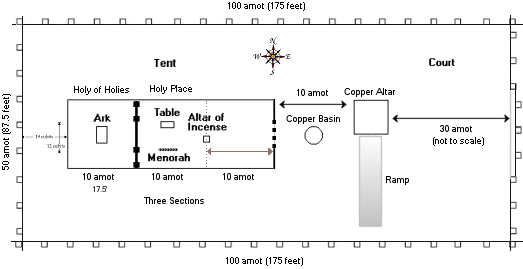 |
Of particular importance was the chest or "ark" (אֲרוֹן) that would be used to store the tablets of the Ten Commandments. Upon the ark would be placed the kapporet (כַּפּרֶת) - a cover of pure gold (sometimes called the "Mercy Seat") upon which were to be fashioned two cherubim (i.e., angel-like figures) that would face one another (1 Pet. 1:12). The wings of the cherubim were to be spread open to shield the cover while their eyes gazed upon the ark. From between the outstretched wings of the cherubim God would appear to reveal additional Torah (Exod. 25:22).
A special table (שֻׁלְחָן) would hold twelve loaves of bread (one for each tribe) along with plates, dishes, bowls, etc. that would be used by the priests as they served in the tent (Exod. 25:23-30). In addition, a seven-branched menorah (מְנוֹרָה) was to be made of beaten gold to resemble a tree. The oil cups used to kindle the lamps were to be in the shape of almond blossoms (Exod. 25:33-34; 37:19-20). (The other furninshings of the tabernacle are described in subsequent Torah portions.)
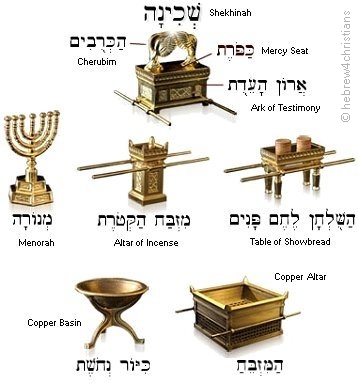 |
At this point I want to digress for a moment to consider a question the sages have asked regarding the meaning of all this in relation to the covenant that was made at Sinai. Recall that after the people heard God speak the Ten Commandments, the LORD said to Moses, "Come up to me on the mountain and wait there, that I may give you the tablets of stone, with the law and the commandment, which I have written for their instruction" (Exod. 24:12). What puzzled the commentators was what the phrase "with the law and the commandment" means in this context, especially since what follows not additional moral laws, but only instructions for constructing the tabernacle....
Some of the commentators claim that Moses did not ascend Sinai for 40 days and nights only to receive the tablets and the instructions for the tabernacle. They cite other places in the Torah where Moses received instructions while at Sinai, for instance, the law of Shemittah (Lev. 25:1-7), the law of the Jubilee (Lev. 25:8-31), the law of redemption (Lev. 25:32-55); and various other laws (Deut. 5:31-6:1). What is not clear from these texts, however, is precisely when these instructions were given. For instance, it is entirely possible that these laws were given when Moses first received the various rules (mishpatim) that were written in the "Book of the Covenant."
The commentator Rashi had such a hard time believing that Moses spent 40 days and nights on the mountain only to be given the tablets and the instruction regarding the tabernacle that he claimed that chapters describing the commandment to build the tabernacle (i.e., Exod. 25-31) actually occured after the sin of the Golden Calf - not before - and therefore the text does not follow chronological order. Contrary to the natural flow of the narrative, then, Rashi claimed that Moses received all of the Torah during the first 40 days and nights on Sinai except for the instructions about building the tabernacle! Apparently Rashi rearranged the narrative this way because he thought that the construction of the tabernacle was intended to atone (or "repair") for the sin of the Golden Calf. According to Rashi, were it not for the sin of the Golden Calf, Israel would not have even needed the tabernacle.

The commentator Nachmanides completely disagreed with Rashi and argued that the narrative is presented in chronological order. Moses' 40 days on the mountain focused on the commandment to create the tabernacle because it was vital that God's Presence accompany the Israelites as they made their way to the Promised Land. The first order of business, so to speak, was therefore to explain how to build a "portable Mount Sinai" that would dwell among Israel in the wilderness.
For a number of reasons is clear that Nachmanides is correct and Rashi is wrong. After all, when Moses first ascended Sinai after the Exodus, he was told that the Israelites would be required to appear before God three times a year, "at the house of the LORD (בֵּית יְהוָה) your God" (Exod. 23:19). Since Moses was told this before the 40 days and nights, it is clear that God originally planned to establish a "house" among the people (Exod. 23:14-19). Moreover, at the beginning of this week's Torah portion it is written: "Let them make me a sanctuary so that I may dwell in their midst" (Exod. 25:8), and this commandment was likewise given before the sin of the Golden Calf.... Finally, the tabernacle reveals that the shedding of sacrificial blood is inextricably bound to the terms of the covenant. Indeed, the Book of Leviticus (ויקרא) is both the physical and spiritual center of the Five Books of Moses and comprises its ritual expression. The sages count 246 of the 613 commandments of the Torah in this book -- over 40% -- that concern laws of sacrifice and the Levitical priesthood. There simply is no true Torah apart from the blood of sacrifice, just as there is no true Christianity apart from the Cross of Yeshua.... "The life is in the blood given on the altar for the atonement" (Lev. 17:11). The role of the tabernacle clearly furthers the concept of the "altar" of the patriarchs, and especially the altar at Moriah where Isaac was bound by Abraham (Gen. 22:1-18).
If we follow the natural (i.e., chronological) order of the narrative, then, we see that the commandment to build the tabernacle was part of the original revelation at Sinai, and the sin of the Golden Calf clearly underscored its need for Israel. As the Book of Leviticus proves, blood atonement is absolutely connected with the giving of the Torah to Israel. (Again, there is no such thing as a "Torah-true" Judaism apart from blood sacrifice, any more than there is true Christianity apart from the cross of Yeshua. The "life is in the blood." )
The Eighth Ascent (the New Covenant)
All of this may be seen more clearly when we consider Moses' final ascent to Mount Sinai, after the sin of the Golden Calf. Recall that after Moses received the first set of tablets, the people had talked Aaron into making a Golden Calf (i.e., chet ha'egel: חֵטְא הָעֵגֶל) which they began to worship (Exod. 32:1-6). The LORD told Moses of their idolatry and threatened to destroy the Israelites, but Moses interceded on their behalf (Exod. 32:7-14). As he rushed down the mountain, with the tablets in hand, he saw the people dancing about the idol. In a fit of indignation, Moses smashed the tablets to the ground (Exod. 32:19). He then destroyed the Golden Calf and instructed the Levites (the only tribe that did not contribute gold for the idol's creation) to slay 3,000 of the ringleaders.

In the aftermath of this grievous sin, Moses despaired of the Jews ever being able to find favor in God's eyes again. (Note: there might have been yet another ascent of Moses at this time, as indicated by Exod. 32:31-35). After being told that Israel should leave Sinai "without Him" (Exod. 33:3), Moses began to lose hope. In a state of grief he moved his tent away from the camp where the Shekhinah Presence began to hover... Moses realized he was at an utter impasse. Would God continue His redemptive plan for Israel or was this the end of the great dream? Therefore we read how Moses poignantly appealed to God: "If I have found favor (grace) in your eyes, let me know your ways, that I may know you and continue in your favor" (Exod. 33:13). God responded by reassuring Moses that His Presence would be with him (alone) and that he (alone) would "enter His rest." But Moses protested: "Unless You go in the lead, do not make us leave this place. For how shall it be known that I have found favor in your sight -- I and your people? Is it not in your going with us, so that we are distinct, I and your people, from every other people on the face of the earth?" And the LORD said to Moses, "This very thing that you have spoken I will do, for you have found favor in my sight, and I know you by name" (Exod. 33:15-17). Moses' successful intercession touched God's heart, causing Him to change from a mode of strict judgment (middat ha-din) to one of mercy and forgiveness (middat ha-rachamim). This was the "gospel" moment at Sinai....
Upon hearing God's words of comfort, Moses was so overcome that he exclaimed: "Oh, let me behold Your Presence!" (Exod. 33:18), whereupon God answered, "I will make all My goodness pass before you, and I will proclaim before you the name LORD (יהוה), and I will be gracious to whom I will be gracious, and will show mercy on whom I will show mercy" (Exod. 33:19, cp. Rom. 9:15).
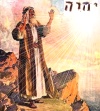
The LORD then instructed Moses to carve a new set of tablets and to meet him again at a place (i.e., ha-makom: הַמָּקוֹם) on the top of Mount Sinai, where He would descend in the cloud to "declare His Name" (Exod. 33:17-34:7). Note that Moses would receive the revelation of the Name when he "stood upon the Rock" (Exod. 33:21). This dramatic experience of revelation was later called middot ha-rachamim, or the revelation of the attributes of God's mercy, and was considered a divine addendum to the original covenant. Jewish tradition later incorporated the recitation of middot ha-rachamim during the observance of Yom Kippur.
What are some of these attributes? Notice first that the LORD calls himself rachum v'chanun (רַחוּם וְחַנּוּן), often translated "merciful and gracious." The noun rechem (רֶחֶם) means "womb" in Hebrew, indicating that God's compassion is like a mother's deep love for her child. The word chanun (חַנּוּן) comes from the word for grace or favor (i.e., chen: חֵן), and indicates that God is a graceful giver who is favorably disposed to help those in need. God is compassionate and favorable to those who call upon Him.
The curious phrase erekh apayim (אֶרֶךְ אַפַּיִם) literally means "long of nose," an idiom used to describe someone who is patient and slow to anger, i.e., "longsuffering" (Prov. 14:29). The word chesed (חֶסֶד), is often translated as "lovingkindess" or "steadfast love," and implies devotion and fidelity. God describes Himself as rav chesed v'emet (רַב־חֶסֶד וֶאֱמֶת), that is abundant in His kindness and faithful love.
יְהוָה יְהוָה אֵל רַחוּם וְחַנּוּן
אֶרֶךְ אַפַּיִם וְרַב־חֶסֶד וֶאֱמֶת
Adonai · Adonai · el · ra·choom · ve·cha·noon
e'·rekh · a·pa'·yeem · ve·rav-che'·sed ve·e·met

"The LORD, the LORD, a God merciful and gracious,
slow to anger, and abounding in lovingkindness and truth."
(Exod. 34:6)
Download Study Card

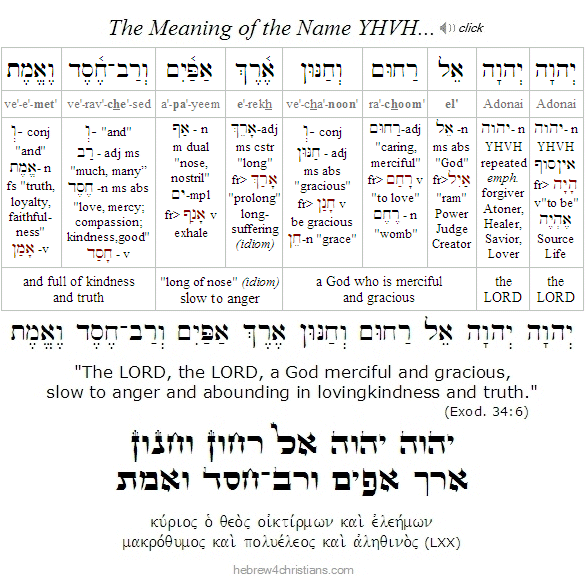 |
It is wonderful to see how this revelation prefigures the New Covenant that was given to Israel. Just as the first set of tablets, based as they were on the justice and holiness of God, were broken, so a second set was given based on the middot (attributes) of the LORD's mercy and grace. Indeed, Yeshua was broken on behalf of the law but was raised again so that all who trust in Him can truly understand that God is "merciful and gracious, slow to anger and abounding in stedfast love and truth" (Exod. 34:6, Psalm 86:15, 103:8).
It can be argued that the deeper revelation of the Name YHVH (יהוה) was a "gospel" moment for Israel. The episode of the Golden Calf revealed that the Jews were unable to keep the law, even though they personally experienced the power of God's deliverance from Egypt and His ongoing care on the way to Sinai. Despite the pledge of the Israelites, "All that the LORD has spoken we will do, and we will be obedient" (Exod. 19:8; 24:7), the Sin of the Golden Calf revealed that something more was needed, and therefore the law by itself was insufficient to "circumcise" the inner heart of man. The intercession of Moses on behalf of Israel revealed the heart of the New Covenant (בְּרִית חֲדָשָׁה) of the LORD, the deeper revelation of the God's character of mercy and grace. Apart from God's gracious love and compassion, the law by itself rendered only the righteous sentence of death for Israel...
As the revelation of the Name discloses, the LORD is rav chesed v'emet (רַב־חֶסֶד וֶאֱמֶת), "abundant in kindness and faithful love." This is demonstrated in the sacrifice of His Son for our sins (John 3:16-17; 1 Cor. 15:3-4; 2 Cor. 5:21). "God has done what the law, weakened by the flesh, could not do. By sending his own Son in the likeness of sinful flesh and for sin, he condemned sin in the flesh, in order that the righteous requirement of the law might be fulfilled in us, who walk not according to the flesh but according to the Spirit" (Rom. 8:3-4).
 |
The great story of the giving of the Torah has a happy ending, of course. Moses finally was able to enter the promised land and stood again with LORD in the cloud covering the mountain, though this was the mountain of Zion rather than Sinai (see Matt. 17:1-5). Because of the avodah (finished work) and intercession of Yeshua, now we can all find favor in God's eyes once again...
|


